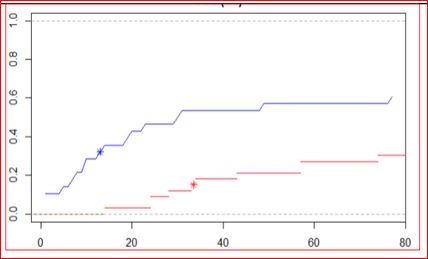Project Goals
The GOHR is a tool to look for "X-Crossings" in Human and Machine Learning. Rules that are easier for humans but harder for machines, and vice versa, such pairs will provide clues as to how machine learning and human learning may be fundamentally different in nature.

Current Findings
This diagram shows cumulative probability distributions for how many moves it takes human subjects to solve each of two different rules. The blue curve shows an "easier" rule - more than 50% of the people solve it, and the median number of moves to solve it (the dot on the curve) is lower (that is, more to the left of the plot).
Current progress is described in our technical reports and publications.
Some visual representations of our findings is described in these linked pages..
Install and use GOHR
The GOHR is available for either psychological research into human learning OR study of machine learning.
Complete instructions on how to download the GOHR and use it in your own research are described here.
To understand the relations between human learning and machine learning we are studying problems where machines and humans can "compete on an equal footing." In this way we can discover pairs of problems where the difficulty is reversed. These "anomalous" pairs will provide a sound basis for partnering human and machine intelligence, with maximum benefit to all humanity.
Our Program
This project uses the Game of Hidden Rules to study human and machine learning on an equal footing.
The initial project team of researchers from UW Madison Engineering and Arts and Sciences was funded by the Wisconsin Alumni Research Foundation, and the National Science Foundation Division of Computer and Information Science and Engineering program in Information and Intelligent Systems. (2041428) .
Lead researchers:
Vicki Bier, Prof, Emerita, Industrial and Systems
Engineering
Paul Kantor, Honorary Associate, Industrial and
Systems Engineering
Gary Lupyan, Professor, Department of Psychology
Xiaojin (Jerry) Zhu, Department of Computer Science
Vladimir Menkov, Computer Systems Analyst, Rutgers University
Other faculty researchers, Post-Doctoral researchers, and
students have made many important contributions to the project.
All of the current and former team members are
listed here.